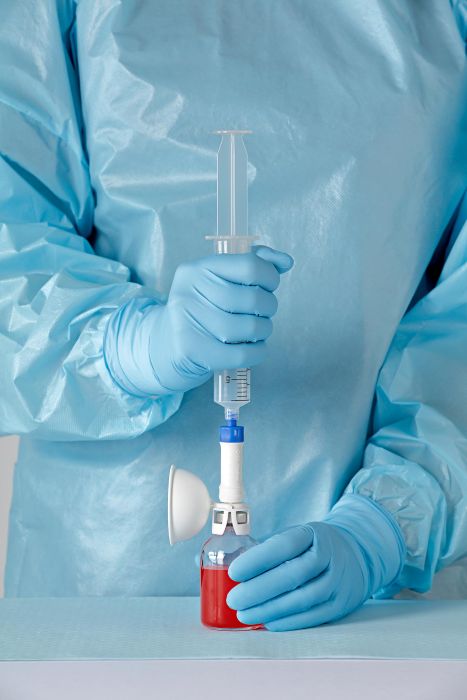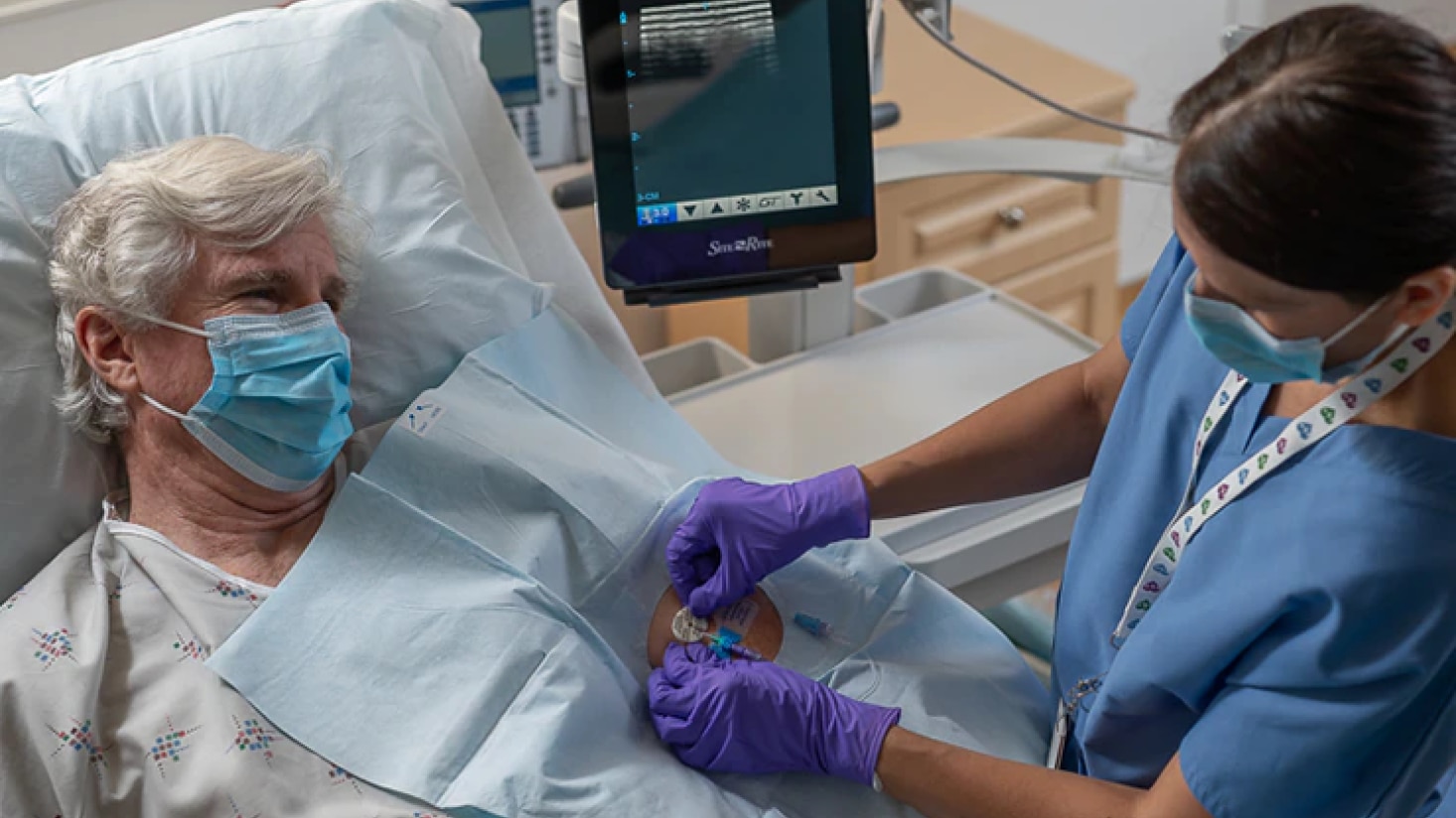BD Vascular Access and Hazardous Drug Safety webinars
Evidence-based webinars from healthcare experts to enhance knowledge and strengthen skills
- Vascular Access Management webinars
- Hazardous Drug Safety webinars
Register Now

From Assessment to Action: A Comprehensive Approach to DIVA
Speakers: Gabrielle Lord BSN, RN, VA-BC
Jon Bell, MSN, RN, VA-BC, CEN
Difficult venous access (DIVA) is a prevalent clinical challenge that affects patient safety, satisfaction, and healthcare resource utilization. Studies indicate that an estimated 22% of people presenting to the emergency department requiring an IV have DIVA, resulting in multiple failed attempts, delayed therapy, and increased costs. This webinar will review the updated definition of DIVA and the SAFE rule for prediction, as proposed by Bahl et al. (2024), and examine the validation and reliability of the Comprehensive DIVA Scoring Tool.
On-demand Webinars
Vascular access is a critical yet often underestimated factor in hospital-acquired infections (HAIs). This webinar features an experienced infection preventionist and a moderator discussing how smarter vascular access practices can reduce infection risk and improve patient outcomes. Using case studies and clinical data, the session explores care breakdowns, compliance challenges, and innovative tools that support infection prevention efforts. Attendees will gain practical strategies for cross-disciplinary collaboration and empowering infection preventionists to lead change.
This session is reporting the results of a randomized controlled trial of 1759 patients to compare integrated vs non-integrated PIVs in adult patients. The primary outcome was device failure (composite: occlusion, infiltration, phlebitis, dislodgement, local, or bloodstream infection). Infection endpoints were assessor masked. The secondary outcomes were: failure type, first‐time insertion success, tip colonization, insertion pain, dwell time, mortality, costs, health‐related quality of life, clinician, and patient satisfaction.
Hospital-onset bloodstream infections remain a significant concern, with inadequate catheter care as a possible contributor-particularly inconsistent disinfection of needleless access devices. Despite established protocols like ANTT® and SASH, adherence to disinfection best practices is frequently suboptimal across both ICU and non-ICU settings. Notably, approximately half of post-insertion infections are linked to contaminated catheter hubs.
To address these challenges, integrated approaches that streamline disinfection and flushing have been explored. One such method combines these steps into a single workflow, promoting aseptic technique and improving compliance. Simulated studies have demonstrated that this approach achieved a 4-log reduction in microorganisms associated with CRBSI* and nearly double compliance rates compared to traditional methods involving separate alcohol pads and flush syringes.
This presentation will examine a compliance study evaluating such an integrated disinfection strategy, featuring insights from a large academic medical center’s implementation experience and its impact on adherence to flushing and disinfection protocols.
*BD Inc. Data on file. In vitro test results may not be predictive of clinical performance.
Demonstrated reduction on the most common causative agents of CRBSI including
Staphylococcus aureus, Staphylococcus epidermidis, Acinetobacter baumannii, Pseudomonas aeruginosa, Escherichia coli, Candida glabrata and Candida albicans.
Implanted ports are often our patient’s lifeline and should be inserted not only following best practices, but with the patient’s quality of life, ease of use, care, and management in mind.
This session will illustrate a physician’s journey to create the optimal scenario for port placement taking into consideration insertion procedure, access, multi-disciplinary collaboration, outcomes, and patient considerations.
Join BD (Becton, Dickinson and Company) and The Health Management Academy for a compelling conversation on transforming everyday clinical practices to improve outcomes, streamline workflows, and elevate the patient experience. While breakthroughs like artificial intelligence and “medical miracles” often steal the spotlight, transformative improvements in routine clinical procedures—those that impact nearly every patient—are frequently overlooked. This session shines a light on the untapped potential of innovating these foundational elements of care delivery. Hear from Dr. Joseph (Joe) Smith, SVP and Chief Scientific Officer at BD; Tamara (Tami) Frost, SVP and Chief Nurse Executive at Carilion Clinic; and Rachelle Landry, VP of Clinical Transformation at BD. Together, they’ll explore persistent challenges in commonly practiced procedures, opportunities to redefine care through innovation and clinical models, and the pivotal role of leadership in driving sustainable change.
Needlestick injuries (NSIs) pose a significant burden on the U.S. healthcare system. Every day, over 1,000 sharps injuries occur in U.S. hospitals, leading to annual costs of up to $1.1 billion5. When healthcare workers or patients are exposed to NSIs, infectious diseases, particularly bloodborne viruses, can be transmitted. The Needlestick Safety and Prevention Act (NSPA) was passed in 2000 to reduce the risk of bloodborne pathogen exposure for healthcare workers. Discover how you can partner with our assessment program that is designed to standardize safety device utilization and help reinforce best practices which includes recommendations and training which may help to reduce potential risk factors affecting NSI rates and costs.
A vesicant is a medication or solution that is capable of causing tissue injury when that substance is inadvertently delivered outside of the venous pathway (ie. extravasation). The severity of patient injury from an extravasation is dependent on multiple factors, such as the route of delivery, the mechanism of action and concentration of the vesicant, patient characteristics, and the amount of vesicant that escapes the venous pathway. In the oncology setting, antineoplastic vesicants and their treatments are well documented. Non-antineoplastic vesicants, however, are much more diverse in mechanism of action, administered in a variety of clinical settings, and are often delivered emergently via peripheral intravenous devices. These factors increase the risk of patient harm and require proactive management to enhance patient safety. This presentation will provide guidance on utilization of the updated 2024 Infusion Nurses Society Evidence-based Non-Antineoplastic Vesicant list relating how vesicant resources are intended to help improve patient outcomes.
The Centers of Medicare/Medicaid Services (CMS) has proposed a new metric: Hospital Onset Bacteremia (HOB). BD surveyed 544 clinicians on their knowledge and preparedness for HOB, and how their practice may be impacted by this new metric. We will share the survey results, identify gaps and opportunities for HOB prevention, identification and treatment in the healthcare space.
Needleless connectors, originally designed to improve the safety of healthcare workers, are increasingly being used to mitigate central line‒associated bloodstream infection (CLABSI) and central venous catheter intraluminal blood occlusion (CVC-IBO) in patients. There are numerous needleless connectors on the market, with varied internal and external design and features. This webinar examines a pending publication comparing the frequency and clinical and financial impact of CVC-IBO and CLABSI among 16 California, USA hospitals using differently designed needleless connectors.
Despite medical advancements, nearly 50% of IVs still fail, over a third of patients facing difficult venous access (DIVA), leading to high-risk outcomes. While ultrasound has proven invaluable for real-time procedural guidance in DIVA cases, its potential extends far beyond the stick. This presentation will address how ultrasound can revolutionize IV procedures, directing clinicians to optimal veins and averting complications even in cases that initially appear suitable for a traditional insertion. Mere visual or tactile assessment often falls short; ultrasound offers objective data, empowering clinicians to make informed decisions based on catheter to vein ratio and vein depth. Moreover, ultrasound extends its utility beyond preparation and placement, aiding in routine IV site management to proactively identify and prevent complications before they manifest. Despite historic barriers like cost and complexity, advancements in ultra-portable ultrasound and artificial intelligence now democratize expertise across the board.
Recent guidelines have recommended coronary computed tomography angiography (CCTA) to be the first-line strategy for evaluating patients with chest pain symptoms. The diagnostic accuracy of CCTA is dependent upon image quality which may be improved by increasing contrast injection rates. Practice guidelines also include using a fenestrated peripheral IV catheter (PIVC). This presentation will review a single center’s experience with fenestrated catheters to improve CCTA image quality and demonstrate methods for achieving high quality images with lower radiation for patients with high BMI.
Peripheral intravenous catheters (PIVCs) play a crucial role in patient care. Up to 90% of hospitalized patients receive a PIVC and 35-50% of those fail prior to completion of therapy. Complications can pose significant risks, both in terms of patient safety and healthcare costs and with many of these being preventable. Understanding how care and maintenance impact the longevity and functionality of peripheral vascular access devices is essential for healthcare professionals striving to enhance patient outcomes and minimize complications. This presentation provides an overview of care and maintenance strategies for PIVCs, emphasizing the critical aspects beyond the initial insertion.
Evidence-based infusion therapy practice is essential to optimize patient outcomes in critical care. Infusion Nurses Society Infusion Therapy Standards of Practice are evidence-based clinical guidelines designed to promote positive outcomes in areas such as site selection, device management, infusate administration, quality improvement, and patient advocacy. The Standards are used globally in settings from home care to critical care and address best practice recommendations for infusates, devices, and routes of delivery. This foundational presentation will describe the methodology used to revise the 2024 Standards, illustrate application of selected standards, and identify research priorities.
Approximately one billion VADs are placed worldwide annually1 with up to 85-90% of all hospitalized patients undergoing IV therapy2,3, resulting in substantial healthcare expenditures2
Given the potential clinical and financial benefits of optimized vascular access (VA) practice, there is an imperative to establish VA teams (VATs) with expertise in VAD selection, placement, and management4
This presentation will review strategies for developing, growing, and optimizing Vascular Access Teams while demonstrating the potential enhancements around clinical and economic outcomes.
Peripheral IV insertion and blood collection are two of the most common inpatient procedures in US hospitals that touch almost every patient every day. Current practices are often accepted as the norm. The hidden cost, clinical quality, and patient experience impacts may be under appreciated and the possibility of a better standard of care may not be envisioned.
Can we challenge the status quo and transform clinical practice? Is there an opportunity to achieve the vision of a ‘one stick hospital stay’- the right IV placed correctly on the first attempt that lasts for the duration of care and can be used for both infusion therapy and blood draws? What does it take to overcome the status quo and implement change? The ability to drive sustainable change is critical to advancing clinical practice. But change requires strong leadership and a disciplined and creative approach that balances the need of nurse engagement with demanding workloads and a primary focus on direct patient care.
Multicenter studies suggest that more than half of ICU patients and approximately 5–7% of all hospitalized patients are affected by acute kidney injury (AKI), which is characterized by a significant loss in kidney function and is associated with increased mortality. Given the prevalence of AKI among critical care patients, device selection can play a key role in successful dialysis treatments within the ICU for optimal CRRT sessions. Dialysis catheter type may be associated with differences in continuous renal replacement therapy (CRRT) treatment in the critically ill, with potential implications for enhanced patient outcomes and healthcare costs. This presentation will review strategies for proper device selection using data from two U.S.-based ICUs and evaluate the impact of short-term dialysis catheters on multiple dialysis treatment outcomes.
In the intensive care unit (ICU) setting, vascular access devices (VADs) are required for different purposes, including blood sampling, administration of fluids and medications, injection of contrast medium for diagnostic purposes, and hemodynamic monitoring. Determining the most appropriate vascular access device for a patient can be challenging. As clinicians, it is important to understand the clinical standards and guidelines when caring for critically ill patients and determining the most appropriate vascular access device. Multiple factors need to be considered as part of the assessment process such as infusates, patient acuity, site selection, duration of therapy, and the proper patient positioning upon insertion. This presentation will review strategies for proper device selection, care, and maintenance that may help reduce complications and optimize patient outcomes.
Human error in hospitals is the third leading cause of death in the United States according to a 2016 study. Mistakes in medical care can be dangerous resulting in death or serious injury. Even the best clinicians can make errors, but what can be done to minimize them in patient care, especially when procedures are being completed by well-meaning but imperfect humans? This presentation will examine the common contributors to human error and while error is part of our cognitive makeup, research in healthcare settings will be reviewed that highlights steps that can be taken to mitigate or “engineer out” some of that risk. Dr. Drews examines the surprising impact of common occurrences in your everyday work life like interruptions, multi-tasking and time pressure that may contribute to error.
An overview of the risks associated with VADs in clinical practice and review of how organizations need to evaluate VAD Care and Management against the INS Standards of best practice. A novel evidence-based data collection tool will be introduced which may help drive clinical decisions as they relate to VADS.
- Rickard CM, Marsh NM, Webster J, Gavin NC, McGrail MR, Larsen E, et al. Intravascular device administration sets: replacement after standard versus prolonged use in hospitalised patients-a study protocol for a randomised controlled trial (The RSVP Trial). BMJ Open. 2015;5(2):e007257.
- Dychter SS, Gold DA, Carson D, Haller M. Intravenous therapy: a review of complications and economic considerations of peripheral access. J Infus Nurs. 2012;35(2):84-91.
- Helm RE, Klausner JD, Klemperer JD, Flint LM, Huang E. Accepted but Unacceptable: Peripheral IV Catheter Failure. J Infus Nurs. 2015;42(3):151-64.
- Pernar LI, Wolf LL, Seshadri A, Patel V. Impact of a Surgeon-Led Peripherally Inserted Central Venous Catheter Team on Peripherally Inserted Central Venous Catheter-Related Complications and Costs. Surg Infect (Larchmt). 2016;17(3):352-6.
- Centers for Disease Control and Prevention. 2008 Sharps Injury Prevention Workbook. Accessed on March 15, 2023, at http://www.cdc.gov/sharpssafety/pdf/workbookcomplete.pdf.
BD-24411 (01/25)
Educational Offerings

Beyond the CSTD Barrier: Insights from the Latest NIOSH Vapor Containment Study
Presented by Stephen Eckel, Pharm.D., M.H.A.S
On-demand Webinars
Administering antineoplastic therapies involves unique challenges, such as managing overfill volumes, safely priming administration tubing, and ensuring thorough flushing practices. These factors are particularly important for small-volume infusions, drugs with a risk of infusion-related reactions, pediatric patients, and research medications. Healthcare professionals must follow evidence-based guidelines to ensure patient safety, treatment effectiveness, and optimal resource use. This webinar will offer a thorough overview of best practices for administering antineoplastic therapies, emphasizing strategies to enhance dosing accuracy and reduce drug waste. Dr. Olsen will cover essential topics such as managing overfill, priming and flushing techniques, and standardized methods for administering high-risk and small-volume infusions. Participants will also learn about innovative approaches to minimize drug waste, ensuring patients receive their full prescribed dose while optimizing healthcare resources. By attending, healthcare professionals will deepen their knowledge of safe antineoplastic administration, help improve clinical outcomes, and promote medication stewardship for effective cancer treatment.
The presentation will review evidence -based guidelines with a focus on the safe handling of hazardous drugs. Reviewing strategies for administration through disposal as well as strategies to help ensure patients received the prescribed dose while minimizing environmental exposure and protecting healthcare workers..
The presentation will review evidence-based guidelines with a focus on the safe handling of hazardous drugs. Reviewing strategies for administration through disposal as well as strategies to help ensure patients received the prescribed dose while minimizing environmental exposure and protecting healthcare workers.
According to the U.S. Centers for Disease Control and Prevention, about 8 million healthcare workers (HCWs) are potentially exposed to hazardous drugs (HD) and minimizing surface contamination is critical for protecting their health. This presentation will describe an approach to select and implement a closed system drug-transfer device (CSTD) in a multisite health-system, review real-world study results on reduction of HD surface contamination, including best practices for ongoing HD detection and monitoring to improve HCW and patient safety.

